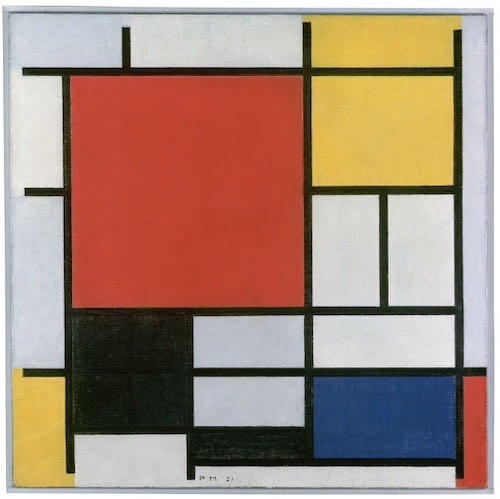
Piet Mondrian. Neoplasticism and the beauty of clean forms.
ArtWizard, 08.07.2019
“To approach the spiritual in art, one will make as little use as possible of reality, because reality is opposed to the spiritual.”
Piet Mondrian
Piet Mondrian is the founder of the Neoplasticism in the abstract art. As he created this style himself in the Netherlands, during the First World War, he explains his inspiration, saying “It is logical that art is the plastic expression of our nature, but it is also logical that art is the expression of the nature inside us and around us.” The new movement he created was part of the circle of Theo Van Doesburg, founded in the Netherlands and based on the geometric order of the lines and the spiritual harmony that was craved at the time by the suffering Europe. The group of Van Doesburg, called their new movement “De Stijl” (The Style). Along with Van Doesburg and Mondrian, the Dutch group also welcomed the Dutch artist Bart Van Der Leck and the Belgian artist Georges Vantongerloo, the principal theoreticians of The Stijl, but it is Mondrian that gave the most eminent artistic vision of it.
.jpeg)
Piet Mondrian, Composition III, c.1930
The painters of the Dutch group claim that the art of De Stijl is founded on the plastic expression of the nature around us, rather than an emotion. This methaphysical dimension makes the neoplasticism closer to the suprematism, but the art of Mondrian is going even deeper into the harmony and contemplation of the one of Kazimir Malevitch. During the years 1920, Van Doesburg is collaborating with the German art group Bauhaus and that influences The Stijl including the diagonal lines into the works. In 1924 Mondrian retires of the group of Van Doesburg who names his style “elementarism”.
.jpeg)
Piet Mondrian, Composition, 1929
The disagreement with Van Doesburg, is about the use of diagonal lines in painting and art work, and this is why Piet Mondrian decided to leave the group, and to start to work on new movements, and new forms of art he had not really entered in to in the past. In 1931, he joins the Abstraction- Creation line, which was more open to new styles, to new techniques, and to a difference in styles of work, which the artists would create. That made Mondrian one of the pioneers of 20th century abstract art, as he changed his artistic direction from figurative painting to an increasingly abstract style, until he reached a point where his artistic vocabulary was reduced to simple geometric elements.
.jpeg)
Piet Mondrian, Composition with red blue and yelow, c.1930
In his way to Neoplasticism, Mondrian took an interest in impressionist techniques and this form of art with the early works that he did. Like Van Gogh, Mondrian use pure, glowing colours and expressive brushwork under the influence of pointillism and Fauvism. The still life images, the landscape design work, and other scenes which he depicted in his early career, all depicted this style. His works start moving towards a pointillist and cubist style, as well as other abstract mediums that he engaged in at this early stage of his career. During that time, Dutch artists were increasingly aware of the radical works of Paul Cezanne and of the Cubist painters. Interest in all types of avant-garde circles, Mondrian was very influenced by the new art movement happening in Paris.
In 1911 he saw for the first time the early Cubist works of Pablo Picasso. He was profoundly impressed. Almost immediately he began to adapt the concept of Cubism to his own use, as evidenced in two versions of Still Life with Gingerpot, done during the winter months of 1911-12. It is interesting to observe how he transformed the objects of the first version of this work, as they have been objects form the everyday life, into the second version of the work, where the artist transformed the same objects into compositional structures taking his drive into adepiction of them more than he ever done this before.

Piet Mondrian, Circa, 1932
Around the year 1932, when he was 60 years old, Mondrian began to be fascinated with the idea of the line and dismantling the very definition of painting. “Drawing and draughtsmanship - exemplified in the line -,” he argued, “had always lain at the heart of painting, from the Renaissance artists to the Impressionists, to the Modernists, and no one had ever thought to challenge that.” Around this time, he strengthens his liens with the UK and United States, and moves to New York in order to escape the Second World War. His style influenced greatly the New York artists after the war. In this way, Mondrian became not only the leader in a progressive style and change in forms, but also influenced the development of American modern art.
.jpeg)
Piet Mondrian, Before Abstraction, 1899
